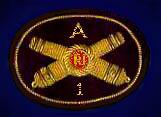 |
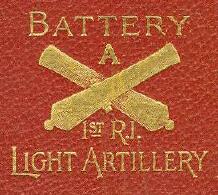 |
 |
 |
 |
 |

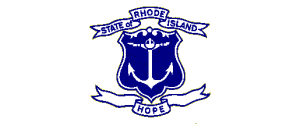






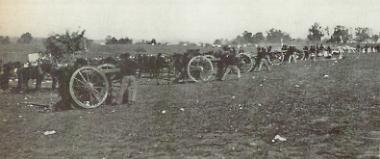 |
The following information is given in response to members of Battery A wanting to know more about black powder cannon drill. All Uniformed members of Battery A, First Regiment, R.I. Light Artillery should be familiar with this information.

FIRING THE PIECE
ARTICLE THREE (on Firing Drill).
MANUAL OF THE PIECE.
This version of the 1864 FIELD ARTILLERY MANUAL, UNITED STATES ARMY, is organized by the pauses and motions of each command, so that an entire gun detachment can be instructed safely at the same time.
CIVIL WAR PERIOD ARTILLERY
COMMAND STRUCTURE.
A 1st or 2nd Lt. shall be in command of a two gun section (left section, center section or right section, of a 6 gun battery) and he shall be the Section Chief and he shall direct the fire of his section, and he shall be one of the most experienced artillerists on the field; each gun, limber and caisson shall have the oversight of a 2nd, 3rd or 4th Sergeant who shall be the Chief of the Piece; each gun shall be under direct firing command of a Corporal and he shall be the Gunner. The limber shall be under direct command of a Corporal and he shall be the Limber Chief. The Gunner is responsible for seeing that his gun is fired safely, efficiently and accurately. The Limber Chief is responsible for seeing his gun and limber is supplied with ammunition, from the limber, the caisson and the ammunition or baggage train to the rear. The caisson shall shuttle ammunition and rotate fresh ammunition or limber chests from the supply train to the gun limber keeping the gun in action. The entire oversight of the operation of firing and supplying each gun shall be the responsibility of the Chief of the Piece.
From the manual.
93. The instructor should bear in mind that, in every change of numbers at the gun, each recruit has to learn different duties, and to handle different implements from those he was previously engaged with; and these, again, vary with the several natures of ordnance and machines which an artilleryman must use. It is impossible that such a variety of exercises can be well executed, or even remembered, unless the recruit is made to comprehend the object of the various duties he is called upon to perform.
For the purpose of instructing the recruit, each gun detachment is to be formed in front of the piece, unlimbered, and the different numbers are to be called upon, successively, to perform their respective duties in detail; while the rest of the detachment look on and observe their motions. When it is found difficult to make the recruit sensible of the defect of his position, etc., the instructor will place himself, or another recruit, in the correct position.
94. Nine men, including the Gunner, are necessary for the service of a field-piece. When, from necessity, the detachment consists of less than nine, the higher numbers are struck out, and additional duties are imposed upon those remaining.
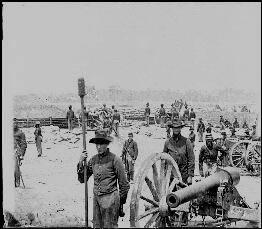 |
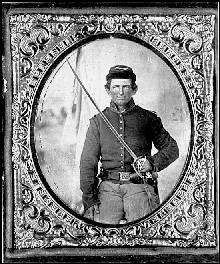 |
POSTS OF THE CANNONEERS. -- PIECE UNLIMBERED.
95. The Gunner is at the end of the trail handspike; Nos. 1 and 2 are about 2 feet outside the wheels, No. 1 on the right, and No. 2 on the left; with howitzers, rather in rear of the muzzle; with guns, in line with the front part of the wheels; Nos. 3 and 4 are in line with the knob of the cascabel, covering Nos. 1 and 2 No. 5 is 5 yards in rear of the left wheel; No. 6 in rear of the limber, and No. 7 on his left, covering No. 5; No. 8, the Chief of the Caisson, is 4 yards in rear of the limber, and on its left; all face to the front.
The Chief of the Piece is opposite the middle of the trail handspike, outside and near the left cannoneers. In actual firing he takes his place on the right or left, where he can best observe the effect of the shot.
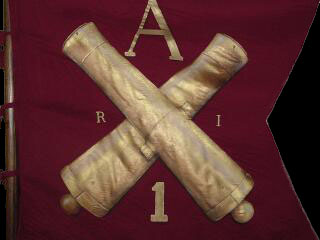 |
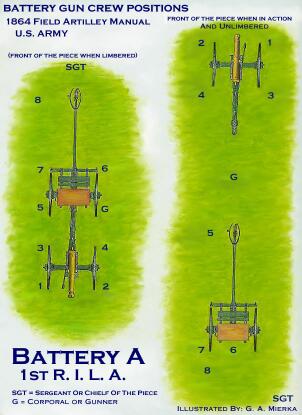
|  |

LOADING AND FIRING THE PIECE.
96. The piece is taken at the drill ground, unlimbered, and prepared for action; the limber in position behind the piece, and facing towards it; the end of the pole 6 yards from the end of the trail handspike.
97. COMMANDING AND POINTING. The Gunner gives all executive commands in action. He is answerable that all the numbers perform their duties correctly. He communicates the orders which he receives for the kind of ammunition to be fired; sending to No. 6 the time or distance for each round, when firing shells or spherical case shot. He should, when the firing is slow, see that each fuse is properly prepared, and make such corrections as are necessary; for this purpose he, as well as No. 6, should be provided with a fuse-gauge.
On receiving the command or signal to commence firing, he gives the command LOAD; takes hold of the handspike at the end with his right hand, and at the center with his left; places his left knee against the left hand, bending over it, the right knee being slightly bent; looks over the top of the piece, and gives the direction. He then steps to the breech to give the elevation, which he does by taking hold of a handle of the elevating screw, drawing back his right foot, bending over his left knee, and sighting over the top of the piece. In the drill of recruits, the Gunner should be made to name the elevation and range before stepping back to the breech.
When the piece is loaded and pointed, he gives the command READY, and, stepping clear of the wheel to that side where he can best observe the effect of the shot, gives the command FIRE. As soon as the piece has been fired, he notes the time, and causes the piece to be run up to its former place, if necessary. After two minutes have elapsed he will ensure that the second wet and dry sponging are accomplished.
When the Instructor, instead of giving the command COMMENCE FIRING, gives that of LOAD, the Gunner repeats it, and performs the same duties as before, except that he does not command fire until the firing is ordered to commence. After the command COMMENCE FIRING is given, the action is continued by the Gunner, without further commands from the Instructor, until the firing is ordered to cease. When the commands are all given by the Instructor, as in loading by detail, the Gunner performs the same duties, but without repeating the commands.
98. The detachment being formed in front of and facing the piece, the Instructor commences by giving the following explanations:
The term CANNON embraces all kinds of heavy ordnance, GUNS, HOWITZERS, MORTARS; each is mounted on a carriage, and each field carriage has a limber.
The term PIECE is applied to the cannon, and is also used to designate it in union with its carriage, with or without the limber attached.
The front of a piece, when limbered, or prepared for moving, is the direction in which the pole points when unlimbered, or when the gun is prepared for action unlimbered, it is the direction in which the muzzle of the gun points; the right and left are in each case determined accordingly.
He then repeats the names of the following objects, indicating each of them.
The LIMBER: ammunition chest, lid, handles; POLE: pole-yoke, branches, sliding ring, pole-prop, and chain; WHEEL: spokes, fellows, nave, tire; PINTLE HOOK, and key.
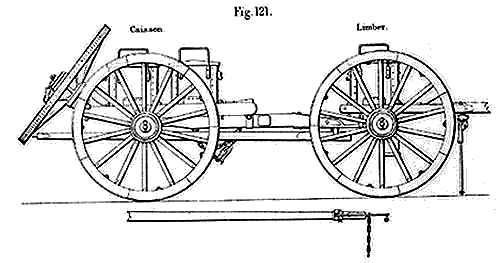 |
 |

The GUN-CARRIAGE: handspike, pointing rings, elevation screw, handles, sponge-hook.
The GUN or HOWITZER, giving explanations of the parts:
The bore is the interior hollow cylinder, which receives the charge.The muzzle is the entrance of the bore.
The face is the front plane terminating the piece.
The vent is the hole through which fire is communicated to the charge.
The trunnions are the projecting cylinders which support the gun.
The Instructor then calls No. 1 to the right side of the piece, and indicates the following parts with his hand, after naming them. The SPONGE: staff, sponge, rammer-head, ferrules.
RAMMER: rammer-head, ferrules. GUN: bore, muzzle, face, vent.
The Instructor places No. 2 on the left of the piece, repeats the nomenclature as for No. 1, indicates the following named objects, and explains their uses; The SPONGE: staff, sponge, rammer-head, ferrules. The WORM: staff, worm head, GUN: bore, muzzle, face, vent. SHOT: Cartridge, ball, sabot; CANISTER SHOT: cartridge, canister; SHELL, or SPHERICAL CASE SHOT: Cartridge, case shot, or shell, fuse.
The Instructor places No. 3 on the right of the piece, indicates the following objects, and explains their uses: TUBE-POUCH; THUMBSTALL; PRIMING WIRE; GUNNERS' GIMLET; FRICTION PRIMER; LANYARD: lanyard hook; VENT: vent field; BREECH: cascabel, knob, and neck of cascabel.
The Instructor places No. 4 on the left of the piece, equips him with a tube-pouch, and repeats the nomenclature as for No. 3.
No. 6 stationed in rear of the limber chest, and issues the ammunition. He is provided with a fuse-gauge, and prepares the shell and spherical case shot according to the distance or time ordered, before delivering it to No. 5.

TO YOUR POSTS ! |
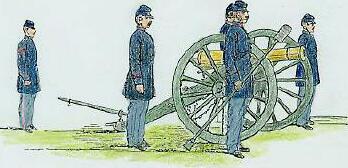 |
NOTE: The "Chief Of The Piece" or Gun Sergeant may at times also stand opposite the middle of the trail handspike, outside and near the left or right of the cannoneers. In actual firing he takes his place on the right or left, where he can best observe the effect of the shot, usually nearer to the limber so he can also monitor the limber chest and the expenditure of rounds fired. He can also hault the firing sequence and assume direct command of the gun crew at any time.
The "Gunner" or Corporal in direct command of the gun and gun crew is at the end of the cannon trail behind the gun's handspike, which he fixes in place after the gun is unlimbered for action.No. 1 stands square to the front, in line with the front part of the wheels, holding the sponge about the middle of the staff in his right hand, and trailing it an angle of 45 degrees, sponge-head up.
No. 2 stands square to the front, in line with the front part of the wheels, holding the worm about the middle of the staff in his left hand, and trailing it an angle of 45 degrees, worm-head up.
No. 3 stands in line with the knob of the cascabel, covering No. 1, the thumbstall on the left thumb, the tube-pouch fastened to the waist.
No. 4 stands in line with the knob of the cascabel, and covering No. 2.
No. 5, stands covering the left wheel, 5 yards in rear of it.
No. 6 stationed at the rear of and centered on the limber chest, and issues the ammunition.
No. 7 stands to the rear of the left limber wheel.
No. 8, the Chief of the Caisson, is 4 yards in rear of the limber, and on its left; all men serving the gun and limber face to the front, which is the muzzle end of the gun unlimbered and deployed for action. No.8 assists the Gunner counting the type and number of rounds fired and echos the Gunner's ammunition commands to No.6 and No.7 serving the limber.

By detail--LOAD ! |
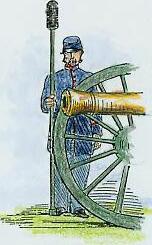 |
No. 1 faces to the left.
No. 2 faces to the right.
No. 3 steps to his left and readies the vent brush.
No. 4 inserts the lanyard hook into the rings of a primer, and stands fast.
No. 5 runs to the ammunition chest, receives from No. 7 or No. 6 a single round which is placed in the ammunition pouches. They are worn by Nos. 5 and 7, hung from the left shoulder to the right side. No. 5 returns to and halts at his post.
No. 6 will be careful not to raise the lid unnecessarily. It should he kept closed when possible. In firing shells and spherical case, he prepares each fuse as directed, assisted, when necessary, by No. 7. TO CUT THE FUSE.--Place the projectile between the knees, fuse uppermost, and support it with the left hand. Holding the fuse-gauge in the right hand, place the left corner of its edge close to, and on the right of, the graduated mark indicating the time desired; then cut away gradually until the composition is exposed fore length about equal to the width of the gauge. Great care must he taken not to expose the composition, to the left of the proper graduation mark, and, to this end, particularly avoid commencing to cut too close to the desired mark; for after the composition is once exposed it is very easy to pare away; to the left, if the time has not been accurately cut. When time permits, it is well to expose the composition fully, either by cutting the opening larger, towards the right, or (with shells only) by cutting another opening to the right of the first. It is in all cases better to enlarge the first opening, and always by extending it towards the right. Care must be taken not to cut the fuse more rapidly than the demand for shells and shrapnel shot requires. He gives No. 5 the time or distance of the fuse with each round issued.
No. 7 places the round in the pouch of No. 5.
No. 8 stands fast.

TEND VENT ! 2 pauses; 3 motions. |
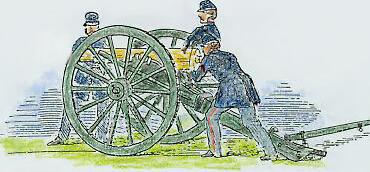 |
At this command: Nos. 1 & 2 stand fast.
No. 3 cleans the vent by inserting and removing the vent brush. He then returns the vent brush.
Nos. 4, 5, 6, 7, & 8 stand fast.
TWO !
Nos. 1 & 2 stand fast.
No. 3 wipes the vent-field with the thumbstall.
Nos. 4, 5, 6, 7, & 8 stand fast.
THREE !
Nos. 1 & 2 stand fast.
No. 3 holds the thumbstall pressed upon the vent, keeping his elbow raised; his fingers on the left side of the piece, so as to allow the Gunner to point over his thumb; the right hand on the tube-pouch.
Nos. 4, 5, 6, 7, & 8 stand fast.

At this command: No. 1 stands fast. No. 2 steps obliquely to the left with his left foot, without moving his right and at the same time bringing the worm smartly to a perpendicular position by drawing his left hand up in line with the elbow. The worm is grasped firmly in the hand, and the end of the shaft-kept just over the left toe, the elbow close to the side.
Nos. 3, 4, 5, 6, 7, & 8 stand fast.
TWO !
No. 2 steps obliquely to the right with his right foot, planting it about half-way between the piece and the wheel, and opposite the muzzle; bringing the worm at the same time across his body to the right, so that his left hand may be opposite the middle of the body, the worm-staff being inclined at an angle of 45 degrees across the front of it.
Nos. 3, 4, 5, 6, 7, & 8 stand fast.
THREE !
No. 1 stands fast.
No. 2 takes a side step to the left of 30 inches, and bending his left knee, brings the worm to a horizontal position, the worm-head to the right, grasping firmly the shaft near worm head with the right hand, the back of his hands down, the worm-head against the face of the piece.
Nos. 3, 4, 5, 6, 7, & 8 stand fast.
FOUR !
No. 1 stands fast.
No. 2 inserts the worm-head, shoulders square, feet equally turned out, straightens the left knee, and, bending over the right, forces the worm home. He fixes his eye on the vent to see that it is closed, gives turns to the worm, taking great care to press it at the same time against the bottom of the bore, and catching the powder bag remnants.
Nos. 3, 4, 5, 6, 7, & 8 stand fast.
FIVE !
No. 1 stands fast.
No. 2 slowly draws out the worm, at the same time straightening his right knee, and bending his left seizes the powder bag remnants with his left hand. This process is repeated at least a second time, until No. 2 is sure that the bore is clear of powder bag remnants, when he places the worm against the face of the piece. During the whole time of clearing, No. 2 keeps his eye on the vent. If at any time it is not closed, he will discontinue the maneuver, and commands STOP VENT. Nos. 3, 4, 5, 6, 7, & 8 stand fast.
SIX ! No. 1 stands fast.
No. 2 He then draws the worm close to his body, and immediately steps back outside the wheel, first with the left, then with the right foot, so that when the left foot is brought to it, the right hip may be on a line with the front of the wheel. In drawing the left foot he places the worm upon the ground and retrieves the dry sponge. He holds the sponge about the middle of the staff in his left hand, and trailing it an angle of 45 degrees, sponge-head up. Nos. 3, 4, 5, 6, 7, & 8 stand fast.

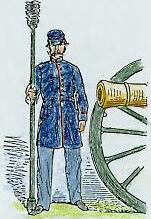 |
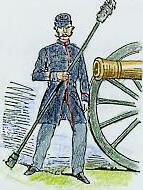 |
First motion of WET SPONGE
At this command No. 1 steps obliquely to the right with his right foot, without moving his left, and at the same time bringing the sponge smartly to a perpendicular position by drawing his right hand up in line with the elbow. The sponge is grasped firmly in the hand, and the rammer-heed kept just over the right toe, the elbow close to the side.
Nos. 2, 3, 4, 5, 6, 7, & 8 stand fast.
Second motion of WET SPONGE
TWO ! No. 1 steps obliquely to the left with his left foot, planting it about half-way between the piece and the wheel, and opposite the muzzle; bringing the sponge at the same time across his body to the left, so that his right hand may be opposite the middle of the body, the sponge-staff being inclined at an angle of 45 degrees across the front of it.
Nos. 2, 3, 4, 5, 6, 7, & 8 stand fast.
Third motion of WET SPONGE
THREE ! No. 1 inserts the sponge head into the sponge bucket. Upon removing the sponge head he removes the excess water and takes a side step to the right of 30 inches, and bending his right knee, brings the sponge to a horizontal position, extending the hands to the ends of the staff, the sponge-head to the left, the back of his hands down, the sponge-head against the face of the piece.
Nos. 2, 3, 4, 5, 6, 7, & 8 stand fast.
Fourth motion of WET SPONGE
FOUR ! No. 1 inserts the sponge-head, drops his left hand behind his thigh, shoulders square, feet equally turned out, straightens the right knee, and, bending over the left, forces the sponge home. He fixes his eye on the vent to see that it is closed, gives two turns to the sponge, taking great care to press it at the same time against the bottom of the bore.
Nos. 2, 3, 4, 5, 6, 7, & 8 stand fast.
Fifth motion of WET SPONGE
FIVE ! No. 1 draws out the sponge, at the same time straightening his left knee, and bending his right seizes the staff near the sponge-head with his left hand, back of the hand up, and places the sponge against the face of the piece. During the whole time of sponging, No. 1 keeps his eye on the vent. If at any time it is not closed, he will discontinue the maneuver, and commands STOP VENT.
Nos. 2, 3, 4, 5, 6, 7, & 8 stand fast.
SIX ! No. 1 then draws the sponge close to his body, and immediately steps back outside the wheel, first with the right, then with the left foot, so that when the right foot is brought to it, the right hip may be on a line with the front of the wheel. In drawing the right foot he places the sponge upon the ground and retrieves the rammer.
Nos. 2, 3, 4, 5, 6, 7, & 8 stand fast.

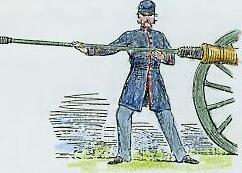 |
DRY SPONGE ! |
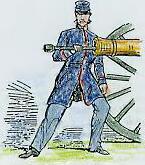 |
At this command: No. 1 stands fast.
No. 2 steps obliquely to the left with his left foot, without moving his right, and at the same time bringing the sponge smartly to a perpendicular position by drawing his left hand up in line with the elbow. The sponge is grasped firmly in the hand, and the rammer-head kept just over the left toe, the elbow close to the side.
Nos. 3 & 4 stand fast.
No. 5 having previously received from No. 2 the time or distance of the fuse with each round issued, No. 5 reports to the Gunner before delivering it to No. 2. In firing shells or spherical case, No. 5 advances to the Gunner and exhibits the fuse to the Gunner before delivering the charge to No. 2.
Nos. 6, 7, & 8 stand fast.
TWO ! No. 1 stands fast.
No. 2 steps obliquely to the right with his right foot, planting it about half-way between the piece and the wheel, and opposite the muzzle; bringing the sponge at the same time across his body to the right, so that his right hand may be opposite the middle of the body, the sponge-staff being inclined at an angle of 45 degrees across the front of it.
Nos. 3, 4, 5, 6, 7, & 8 stand fast.
THREE ! No. 1 stands fast.
No. 2 takes a side step to the left of 30 inches, and bending his left knee, brings the sponge to a horizontal position, extending the hands to the ends of the staff, the sponge-head to the right, the back of his hands down, the sponge-head against the face of the piece.Nos. 3, 4, 5, 6, 7, & 8 stand fast.
FOUR ! No. 1 stands fast.
No. 2 inserts the sponge-head, drops his right hand behind his thigh, shoulders square, feet equally turned out, straightens the right knee, and, bending over the right, forces the sponge home. He fixes his eye on the vent to see that it is closed, gives two turns to the sponge, taking great care to press it at the same time against the bottom of the bore.
Nos. 3, 4, 5, 6, 7, & 8 stand fast.
FIVE ! No. 1 stands fast.
No. 2 draws out the sponge, at the same time straightening his right knee, and bending his left seizes the staff near the sponge-head with his right hand, back of the hand down, and places the sponge against the face of the piece.
During the whole time of sponging, No. 2 keeps his eye on the vent. If at any time it is not closed, he will discontinue the maneuver, and commands STOP VENT.Nos. 3, 4, 5, 6, 7, & 8 stand fast.
SIX ! No. 1 stands fast.
No. 2 then draws the sponge close to his body, and immediately steps back outside the wheel, first with the left, then with the right foot, so that when the left foot is brought to it, the left hip may be on a line with the front of the wheel. In drawing the left foot he places the sponge upon the ground.
Nos. 3, 4, 5, 6, 7, & 8 stand fast.

RAM ! |
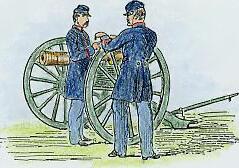 |
101. At this command: No. 1, steps obliquely to the right with his right foot, without moving his left, and at the same time bringing the crooked handle rammer smartly to a perpendicular position by drawing his right hand up in line with the elbow. The crooked handle rammer is grasped firmly both hands and held to the front close to the body. The right hand is placed on the short shaft of the rammer, the left hand on the long end with the rammer head.
No. 2 receiving ammunition from No. 5.
He steps obliquely to the left with his left foot, planting it about half-way between the piece and the wheel, and opposite the muzzle; bringing the rammer at the same time across his body to the left, so that his right hand may be opposite the middle of the body, the rammer-staff being inclined at an angle of 45 degrees across the front of it.
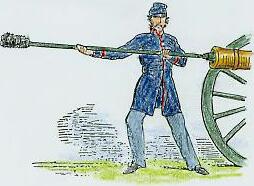 |
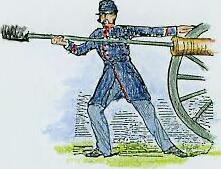 |
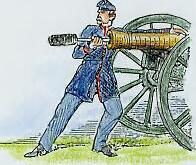 |
No. 2 by two oblique steps, corresponding to those of No: 1, the first with the left, the second, with the right foot, he places himself near the muzzle of the piece. He brings up his left foot to the side of the right, and faces to his rear bringing his hands together to receive the ammunition from No. 5, the cartridge in the right, the shot in the left hand.
Nos. 3, & 4 stand fast.
No. 5 advances with the round holding open the pouch, and No. 2 takes out the round with both hands. No. 5 returns immediately for another round, and then halts at his post. In rapid firing with round shot and canister Nos. 5 and 7 may alternate in delivering the charges to No. 2, especially when the ammunition is issued direct from the caisson.
Nos. 6, 7, & 8 stand fast.
TWO ! No. 1 takes a side step to the right of 30 inches, and bending his right knee, brings the rammer to a horizontal position, the rammer-head to the left, the back of his right hand up, and that of his left down, taps the muzzle and brings the rammer-head against the face of the piece.
No. 2 faces to his rear by the left, and puts the ammunition into the muzzle, taking care that the painted end of the cartridge is inserted into the bore first, and then steps back, commencing with his left foot, to his position outside the wheel, in the same manner that No. 1 does, and retrieves the worm.
Nos. 3, 4, 5, 6, 7, & 8 stand fast.
THREE ! No. 1 introduces the rammer-head into the muzzle as soon as No. 2 has inserted the charge, casting his eyes to the front. He extends his left hand towards the left trunnion.
Nos. 2, 3, 4, 5, 6, 7, & 8 stand fast.
FOUR ! No. 1 rams home, throwing the weight of his body with the rammer; bending over his left knee, and passing his left arm, with the elbow slightly bent, and back of the hand up, in a horizontal position-over the piece, until it points in the direction of the left trunnion; the right shoulder thrown back, and the eyes cast towards the front until the cartridge is home.
Nos. 2, 3, 4, 5, 6, 7, & 8 stand fast.
FIVE ! No. 1 withdraws the rammer out with his right hand. Once removed and being careful never to place his hands in front of the muzzle he grasps it firmly, and seizing the long shaft with the rammer head with the left hand, back of the hand up, places the rammer-head against the face of the piece; both knees straight; eyes to his own front.
Nos. 2, 3, 4, 5, 6, 7, & 8 stand fast.
SIX ! No. 1 then draws the rammer close to his body, and immediately steps back outside the wheel, first with the right, then with the left foot, so that when the right foot is brought to it, the right hip may be on a line with the nave of the wheel. In drawing the right foot to the left, he places the crook of the rammer on the nave of the wheel.
No. 2 stands fast.
No. 3, When the piece is sponged, and the charge rammed by No. 1, jumps to the end of the trail handspike, and, seizing it with both hands, prepares to move it to the right or left, on it signal from the gunner, who taps the right of the trail for a movement to the left, and the left of the trail for a movement to the right. As soon as the piece is pointed, the Gunner raises both hands as a signal to No. 3, who then resumes the position TO YOUR POSTS.
Nos. 4, 5, 6, 7, & 8 stand fast.
No. 1 at READY. Sometimes for safety and training purposes a crooked handled rammer should be used.

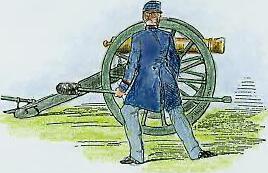 |
READY ! |
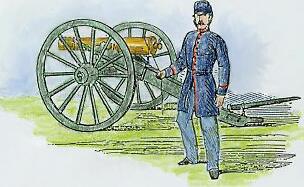 |
When the piece is loaded and pointed, the Gunner gives the command READY.
At this command, which is given as soon as the piece is loaded, or the firing about to commence, No. 1 breaks well off to his left with the left foot, bending the left knee, and straightening the right leg, and fixes his eyes on the muzzle. The heels should be parallel to the wheel, the body erect on the haunches, and the rammer held in both hands in a horizontal position, rammer-head to the left.No. 2 breaks well off to his right with the right foot, bending the right knee, and straightening the left leg, and fixes his eyes on the muzzle. The heels should be parallel to the wheel, the body erect on the haunches, and the worm held in both hands in a horizontal position, worm-head to the right.
No. 4 at READY.
No. 3 steps in to the piece, takes the priming wire in his right hand, thumb and finger holding the wire just below the ring, pricks the cartridge, taking care not to move the charge, and holds the lanyard to the left side of the piece with the fingers of his left hand as soon as the tube is inserted. He maintains eye contact with No. 4 until the lanyard is taught and the he acknowledges the nod from No. 4 signaling that No. 4 is ready. He then steps to his right, clear of the wheel, and at the flash of the gun, or at the command LOAD, serves vent as before. No. 3 should be careful to keep the vent closed from the time the sponge enters the muzzle until the charge is rammed by No 1.
No. 4 steps in with the right foot, drops the tube in the vent, takes the lanyard in his right hand, moves to the rear, maintaining eye contact with No. 3, so far as to keep the lanyard slack, but capable of being stretched, without altering his position, which should be clear of the wheel, left foot broken to the left and rear. He then signals No. 3 that he is ready by a nod of the head, then turns his head to the left and notifies the Gunner that the piece is ready to fire.
Nos. 5, 6, 7, & 8 stand fast.
The Gunner stepping clear of the wheel to that side where he can best observe the effect of the shot, gives the command:
 |
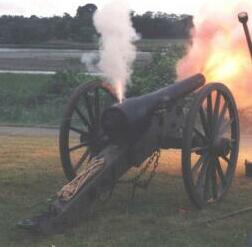 |
 |
At this command: Nos. 1, 2, & 3, stand fast.
No. 4 pulls the lanyard briskly and firmly, passing the hand, back up, in a downward direction to the rear, so as to keep the lanyard hook from flying back in the direction of the face. Should the tube fail to explode the charge, the Gunner immediately commands, DON'T ADVANCE, THE PRIMER HAS FAILED! Upon which No. 2 steps inside the wheel, close to the axle tree, receives from No. 3 over the wheel a priming wire, and from No. 4 a prepared primer, pricks, primes, and resumes his post. At the command CEASE FIRING, NO. 4 secures his lanyard.
Nos. 5, 6, 7, & 8 stand fast.
The Gunner, as soon as the piece has been fired, notes the time, and causes the piece to be run up to its former place, if necessary. After two minutes have elapsed he will ensure that the second wet and dry sponging are accomplished.
The piece having been fired, No. 1 rises on his right knee, places the rammer on the ground, retrieves the sponge and returns to his position, as in the third motion of Ram. At the command LOAD, he steps in and performs his duties in the same manner as before.
The piece having been fired, No. 2 rises on his left leg, remains facing the piece until he hears the command LOAD, or observes the flash of the gun, then steps in and performs his duty as before.

The Gunner stands fast.
Nos. 1, 2, & 3 continue to Tend the Vent, Clear, Wet Sponge and Dry Sponge until the sequence is complete.
No. 1 takes his position, to the right side of the piece, 2 feet outside the wheel and faces to the front as at: TO YOUR POSTS.
No. 2 takes his position, to the left side of the piece, 2 feet outside the wheel and faces to the front.
No. 3 takes his position, in line with the knob of the cascabel, covering No. 1. He secures the priming wire and vent brush.
No. 4 is in line with the knob of the cascabel, covering No. 2. He secures the friction primer and lanyard.
No. 5 carries the round back to No. 6, and returns to his post.
No. 6 carefully replaces the ammunition in the chest and secures the lid.
Nos. 7, & 8 stand fast.
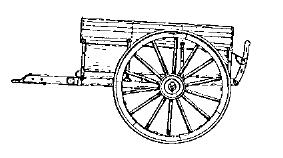 |

REMARKS ON THE DUTIES OF NO. 1.
104. The position of the left foot will not be considered as absolute; it is given as the usual one, and may be modified according to the caliber of the piece and height of the man. The same remarks will apply to the distance between the feet. They will be placed in such position, and at such distance from each other, as will enable the man to perform his duties with the most case and steadiness, and at the same time exert his full strength, which will always be required after firing a few rounds, especially when a new sponge is used.
One object of casting the eyes to the front whilst ramming, is to refuse the right shoulder, and to secure this object the left hand, when it posses over the piece, is not carried further back than the direction indicated. This will keep the shoulders in a line parallel with their position at the commencement of the movement, until the cartridge is set home, and thus guard against fatal results in case of a premature discharge.
REMARKS ON THE DUTIES OF NOS. 3 & 4.
108. No. 3, as well as No. 4, should be equipped with a tube-pouch, furnished with friction primers and lanyards. In the absence of No. 4, immediately after pricking the cartridge, he prepares and inserts a tube, steps to his post, faces the vent, breaks to his rear with the left foot, and at the command FIRE, discharges the piece. He then resumes his post, and tends the vent as before.
110. LOADING BY DETAIL.--For the instruction of recruits united for the service of the gun, the exercise is conducted by detail, the Instructor giving all the commands. His commands are: load by detail--LOAD; TEND VENT, TWO, THREE, CLEAR, TWO, THREE, FOUR, FIVE, SIX: WET SPONGE; TWO, THREE, FOUR, FIVE, SIX: DRY SPONGE; TWO, THREE, FOUR, FIVE, SIX: RAM; TWO, THREE, FOUR, FIVE, SIX: READY; FIRE; CEASE FIRING.
When the men are sufficiently instructed to go through the manual without detail, the commands of the Instructor for that purpose, are: LOAD; COMMENCE FIRING; CEASE FIRING; Or simply COMMENCE FIRING and CEASE FIRING. After the command COMMENCE FIRING, the action is continued as laid down for loading without detail, until the command CEASE FIRING is given, which is repeated by the chief of the piece and the gunner.

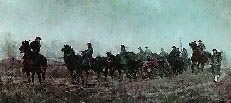



|
|  Get your own Free Home Page Get your own Free Home Page |
{Return To The Top of This Page}